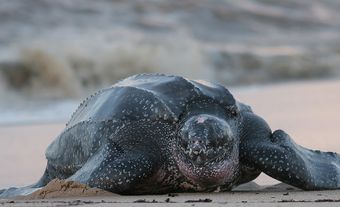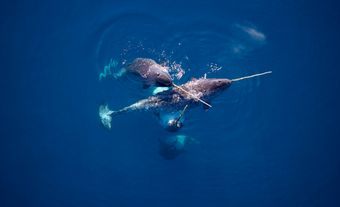Whaling, the practice of hunting whales, has a long history in the waters around Canada. Various Indigenous Peoples were the first to hunt whales in these areas. Later, European, American and Canadians hunted whales extensively. About 33 species of whales occur in Canadian waters, of which about 13 have been commercially significant. The species that were hunted the earliest were the easiest to hunt, such as the right whales, bowhead whales and grey whales. As the numbers of these species declined, humpback whales and sperm whales became the preferred prey. Later still, when technological advances made it feasible, the very fast blue whales, fin whales and sei whales were taken. This whaling also had a significant and largely negative impact on many Indigenous Peoples and nearly resulted in the extinction of various whale species. Today, all commercial whaling is banned in Canadian waters.

History
The first whalers in Canada were Indigenous Peoples, such as the Nuu-chah-nulth of Vancouver Island and various Inuit communities, who hunted for subsistence. As early as the 16th century, however, Basque seamen from France and Spain sailed to the Gulf of St Lawrence, where large numbers of whales congregated each summer to feed to hunt for commercial purposes.
Atlantic Seaboard
In the 18th century, British and American ships cruised the Atlantic seaboard. In the 19th century, Canadians entered the field, establishing a whaling station in Newfoundland and taking whales as part of a deep-sea fishery operation from Gaspé. Norwegian whalers entered the area toward the end of the century, establishing stations in Newfoundland and Labrador and the Gulf of St Lawrence.
Pacific Coast
Beginning in the 1830s, American whalers cruising north to the Bering Sea hunted whales migrating along the Pacific coast. A local Canadian industry was established briefly (1868-72) at harbours on Vancouver Island and in the Gulf of Georgia. From 1905, at least one company operated at any given time (excluding 1942-47) until 1967, when the last Canadian West Coast whaling company (the Western Canada Whaling Co) ceased whaling.
Davis Strait and the Arctic
Whaling began in the Davis Strait region of the Arctic in the 17th century. Dutch, German, English and Scottish whalers largely confined their efforts to the eastern (Greenland) side until the expeditions of John Ross (1818) and W. Edward Parry (1819) crossed Baffin Bay and showed the way to Lancaster Sound. The northernmost extent of whaling was Ellesmere Island. The most important area for autumn whaling was Cumberland Sound. Whaling activity peaked from 1820 to 1840, when there were sometimes almost 100 vessels in the Davis Strait area; in some years, the catch exceeded 1,000 whales.
Ordinarily, arctic whaling voyages lasted a single summer; ships arrived in Davis Strait in April and tried to begin the return journey by October. However, on many occasions, vessels were trapped by ice and either imprisoned through the winter or sunk. While British whalers dominated the Davis Strait grounds, US ships opened the northwest corner of Hudson Bay (1860) and, after 1889, pushed past Point Barrow in the Beaufort Sea. By the late 1890s, vessels had penetrated the Amundsen Gulf. Compared to the eastern Arctic, whaling in the Beaufort Sea was of short duration (1889-c1914). These areas were so inaccessible that whalers extended their visits over a year, spending the winter months frozen in sheltered harbours to get an early start in spring. The population of whalers was not large: at most, 500 seamen wintered in the Beaufort Sea and 200 in Hudson Bay. Wintering did not begin on Baffin Island until the 1850s. It was not until later in the century that permanent shore stations, such as Kekerton and Blacklead Island on Cumberland Sound, were established.
Impact on Indigenous Peoples & the Arctic
The impact of the whalers on the Inuit was profound. Indigenous people were employed as pilots, hunters, dog drivers and seamstresses, often in order to be able to procure European trade goods. Contact between whalers and Inuit at shore stations inevitably resulted in the spread of European diseases. Epidemics of measles, typhus and scarlet fever swept through the Indigenous population (see Epidemics in Canada). At the beginning of the 20th century an entire people, the Sadlermiut of Southampton Island in Hudson Bay, were wiped out. The influx of whalers placed a great strain on Arctic resources. Caribou herds were decimated to provide meat for the ships' crews. As supplies of meat and leather dwindled and tastes changed, many Inuit relied on food and clothing traded from the whalers. Some Indigenous people were employed on the ships as hunters or crewmen, and increasingly, the economic life of the Inuit was changed.
Political Impact
The activities of foreign whalers in the Arctic stimulated the Canadian government to assert sovereignty over the Arctic Archipelago. Officially, these islands had belonged to Canada since 1880, but no presence had been established, and foreign whalers continued to operate in the Arctic without any regulation. By 1900, suspicions were growing that the US planned to annex the area, using the activities of American whalers as a pretext. Detachments of North-West Mounted Police were established (1903) to collect customs, regulate the liquor traffic, impose whaling licences and maintain order.
Whale Products
Whales have been valued for different products at different times. The Inuit used all of the whale: skin, blubber, flesh and internal organs were eaten; baleen and bones were used for buildings, furniture and innumerable smaller items; oil provided heat and light. Europeans were more wasteful. Initially, oil extracted from blubber was used in street lamps and for soap. By the late 19th century, coal gas and petroleum products replaced animal oil as an illuminant, but it continued to be used in margarine, paints and varnishes, and as a lubricant. The waxy spermaceti produced by sperm whales was used for candles, lubricants, cosmetics and shoe polish.
In Canadian waters, the most important whale was the bowhead whale, which supplied baleen (whalebone), a substance that hangs in long, curtain-like strips from the roof of its mouth. A large bowhead might produce over 700 strips. By the end of the 19th century, removing baleen and discarding the carcass became common practice. This flexible substance was used for various products, including buggy whips, skirt hoops, umbrellas, carriage wheels, corset stays and fishing rods. It was replaced in the 20th century by spring steel and plastics. Whale meat has been used for human consumption, chiefly in Japan and Norway, and for animal food.

Hunting Tactics
At first, commercial whalers armed with hand-held harpoons and lances pursued the animals in small boats. The harpoon was thrust into the whales, and the animal was allowed to run out of line. "Nantucket sleigh rides" occurred when all the line had run out, and the whale was "tethered" to the boat. When the whale was exhausted, the whalers moved in for the kill. New weapons were introduced in the middle of the 19th century. The shoulder gun fired an explosive missile with a time fuse, which detonated inside the animal. The harpoon gun, a cannonlike weapon mounted at the boat's bow, fired a barbed harpoon with an explosive charge attached. Such weapons transformed the hunt from a contest to a slaughter.
The steam engine was first applied to whaling ships in the 1850s. By 1870, most of the Davis Strait fleet had converted to steam, and American whalers in the Beaufort Sea quickly followed suit. The increased speed, power and maneuverability allowed whalers to carry the hunt farther from home ports and reduced the dangers of ice and storms.
Whaling Ban & Conservation
In the Arctic, commercial whaling had all but ceased by the outbreak of the First World War (WWI). Whale stocks were depleted to extinction, and the demand for baleen decreased. Along the British Columbia coast, however, and in Newfoundland and Nova Scotia, whaling continued from several land-based stations with catcher boats pursuing and killing whales and towing the carcasses to land for processing. Whaling entered a new phase internationally in 1925 with the introduction of factory ships. Annual catches rose dramatically: in the late 1930s, more than 50,000 whales were taken annually. After the formation of the International Whaling Commission (IWC) in 1946, the killing of several species was banned completely, and quotas were established to control the exploitation of the rest. In 1972, the federal government ordered a halt to all whaling operations based in Canadian ports. The last West Coast company stopped whaling in 1967; thus, the government order affected only two shore-based operations in Newfoundland and one in Nova Scotia. The Inuit are still allowed to take whales. As a result of conservation measures, some whale stocks have shown signs of recovery. In the 1930s, the bowhead whale was considered on the brink of extinction and declared an endangered animal. Recent studies indicate that it has survived and may recover slowly in some areas.
Canada was a member of the IWC but withdrew from the organization in 1982. The commission had achieved some significant success; however, because member nations are not bound to conform to its recommendations, the commission can be only as effective as the whaling nations allow. Decisions have often been tempered by the desire to keep nations in the organization, where some control is possible, rather than outside, where their activities would be totally unregulated. Canada disagreed with efforts in 1980 to declare a moratorium on commercial whaling because, in the absence of a clear and scientifically justified recommendation for such action from the commission's scientific committee, it felt that conservation requirements could be met under the commission's management procedure, which provides for selective moratoria (zero quotas). Canada's position on the moratorium issue earned a great deal of criticism from anti-whaling groups. Nevertheless, a moratorium announced in 1982 took effect on 1 January 1986. Although no longer a member of the IWC, Canada continues to ban commercial whaling in its territory and continues to cooperate with the commission's scientific committee.
See also Wildlife Conservation and Management.

 Share on Facebook
Share on Facebook Share on X
Share on X Share by Email
Share by Email Share on Google Classroom
Share on Google Classroom



